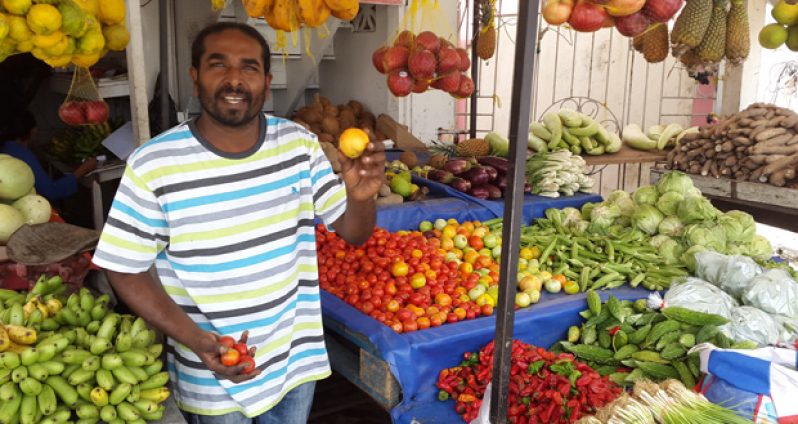By Rabindra Rooplall
IN the midst of El Nino weather, the prices for certain cash crops have been rising and farmers are justifying this increase, but consumers in some instances are bypassing the higher prices by using substitutes in their meal preparations.A cash crop is an agricultural crop which is grown for direct sale in the market to return a profit, but many consumers who spoke to this publication said that while they understand that prices will rise because of the El Nino effect, they have to utilise substitutes to avoid the ‘unnecessary expense.’
“Money ain’t easy to come by and I don’t care what El Nino causing, my money hasn’t increased for the market and other things will have to substitute for the vegetables and fruits that gone up,” one housewife said frankly.
The dry weather is officially here and most meteorologists expect El Niño to hang around until at least early 2016, and farmers have already felt the effects of this weather phenomenon and its impact on their crops.
‘MY FARM DRY, DRY’
Farmer Chaterpaul Bharrat said the weather pattern has wreaked havoc on his crops, but the recent rainfall saved acres of fruits and vegetables.
The Canal Number Two, West Bank Demerara planter, who has been farming for decades, said that “with limited rainfall, the cash crop them very difficult to produce, and people don’t buy much because cost go up for the crops. I could carry anybody for a visit on my farm and let them see in Canal how my farm dry, dry, I have to use a pump to water my crop.”
Noting that at present the fruits and vegetation have stifled, Bharrat said he has not even been getting the normal size of tomatoes, peppers or in some cases fruits, as the “rains give the plant the little nitrogen and stuff that all crops need to bloom. And the trench water don’t give the same thing, yuh have to get black water, right now we ain’t even reaching to the black water creeks because all over dry.”
He continued: “Whole day yo got to pump water for cash crops, plantation crops like pak choi, celery, bananas, pineapples, lettuce, eschallot, you name it and its pressure when there is limited supply of water.”
Expressing optimism, the cash crop farmer said that rain will be falling sooner than later, since slight drizzles and a mild shower were recorded. “Ah mean the weather man say is until next year we getting proper rain, but according to the dry weather, nobody can’t predict God’s work and I am hoping for more rainfall for now… the two showers that fall the other day save thousands of tomatoes for me.”
PONDS
He recommended that the Agriculture Ministry and donor agency should assist small-scale farmers by digging large ponds in farming communities that can store water in addition to assisting poor farmers with pumps and necessary training to deal with these weather conditions.
Another farmer selling his produce noted that Guyana has rich fertile land that can be reaped, which will maximise Guyana’s production because there is a food shortage globally. The farmer explained that harvest losses have several causes, including bad timing and poor conditions during the harvest as well as inadequate techniques and equipment. Similarly, lack of good infrastructure for transportation, storage, cooling and marketing would cause food to spoil, especially in hot climates.
NEED FOR INVESTMENTS
Meanwhile, several farmers collectively noted that both the private and public sectors need to increase investments to address shortcomings in farming. They said further that doing so will also have additional benefits for food security and mitigating climate change, land degradation and biodiversity erosion.
Meanwhile, Dr. Oudho Homenauth, Chief Executive Officer of the National Agricultural Research and Extension Institute (NAREI), told this publication that the periods of El Nino are particularly difficult for farmers in many parts of the country.
DROUGHT-RESISTANT CROPS
He recommended that farmers plan for the year ahead by planting drought- resistant crops which can adapt to survive long periods of dryness. Examples include saime, yams, cassava, okra and bananas among others, and trees such as breadfruit, coconut and mango are also drought-tolerant.
There is a chance that fruit trees will fruit heavily as the climate dries further and it would be wise for communities to preserve these fruits for future use, so that they are not wasted.
Another possible way to make the most of limited rainfall is through a multi-storey cropping system. Dr Homenauth explained that land underneath coconut trees is often wasted, but it can be used more productively by planting additional crops, growing to different heights with different root systems, providing more diverse food during a drought. For example in dry areas papaya and pineapple can be planted under coconut trees.
“Mulching and drip irrigation are other effective ways of conserving limited water supplies, whilst composting can provide additional nutrients to help plants survive. Watering crops late in the day can also reduce evaporation,” he explained.
He also noted that much of the environmental impact of irrigated agriculture is linked to the management of water and salt balances of irrigated lands.
Dr Homenauth pointed out that increases in the salinity of rivers and streams in many dry parts around the country would stifle the development of crops.




.jpg)









